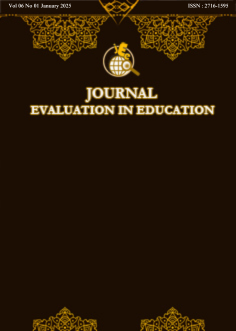Social Practices of Literacy and Numeracy Through Culturally Responsif Teaching (CRT) Approach in Sociology Learning
Abstract
Purpose of Study: This study aims to identify social practices of literacy and numeracy using the CRT approach in Sociology learning.
Methodology: This research uses a descriptive qualitative approach with a phenomenology type. The data source consists of focus group discussion (FGD) results, observation, and document analysis. FGD involves sociology teachers in Soloraya, with the purposive sampling technique used to select informants. Observation was carried out directly by observing the sociology learning process in the class. Document analysis includes teaching modules, sociology learning gain, student worksheets, and other learning sets. Data validity was tested using source and method triangulation. Data analysis was done using Interpretative Phenomenology Analysis, encompassing four stages: bracketing, intuiting, analyzing, and describing.
Main Findings: The result of the research shows that teachers get a support system from government regulation, the Merdeka Mengajar platform, the learning community, the supervisor, and the subject teacher working group. Each of the parties plays a role that supports CRT-based literacy and numeracy learning. The learning activity can be identified in three things. Firstly, teachers hold the authority to accustom the students to using numeric data in the context of local culture. Secondly, teachers integrate numeric data from local cultures to make learning more relevant and contextual. Thirdly, teachers create an inclusive learning environment by accommodating numeric data in the context of local culture.
Novelty/Originality of Study: By applying CRT, sociology teachers teach literacy and numeracy skills and help students see the relevance of these skills in understanding and participating in social change.
References
A. Hartoyo and D. Rahmadayanti, “Potret Kurikulum Merdeka, Wujud Merdeka Belajar di Sekolah Dasar,” J. Basicedu, vol. 5, no. 4, pp. 2247–2255, 2022, doi: 10.31004/basicedu.v6i4.3431
B. Bennett, H. Redfern, and J. Zubrzycki, “Cultural Responsiveness in Action: Co-Constructing Social Work Curriculum Resources with Aboriginal Communities,” Br. J. Soc. Work, vol. 48, no. 3, pp. 808–825, 2018, doi: 10.1093/bjsw/bcx053.
V. Hargraves, “The principles of culturally responsive teaching,” Educ. Hub, pp. 1–8, 2019.
D. A. H. Putri, A. Asrizal, and U. Usmeldi, “Pengaruh Integrasi Etnosains Dalam Pembelajaran Sains Terhadap Hasil Belajar: Meta Analisis,” ORBITA J. Pendidik. dan Ilmu Fis., vol. 8, no. 1, p. 103, 2022, doi: 10.31764/orbita.v8i1.7600.
A. Larasati, T. Sunarti, and Budiwati, “Implementasi Pendekatan CRT untuk Meningkatkan Motivasi Belajar Peserta Didik pada Pembelajaran Fisika,” PENDIPA J. Sci. Educ., vol. 7, no. 1, pp. 94–99, 2023.
T. Taher, "Analisis Keterampilan Komunikasi dan Kolaborasi Siswa Introvert dengan Pendekatan Culturally Responsive Teaching. Jambura J. Educ. Chem., vol. 5, no. 1, pp. 21–27, 2023, doi: 10.34312/jjec.v5i1.17463.
J. Muniz, “Culturally Responsive Teaching: A Reflection Guide,” p. 20, 2020.
J. H. Ballantine, K. A. Roberts, and K. O. Korgen, Our Social World: Introduction to Sociology, vol. 1999, no. December. United States of America: Sage Publications, Inc, 2018.
M. Fernández-Esquinas, “Dealing with the profession of sociology: opportunities and problems at the interface between training and professional development,” Int. Rev. Sociol., vol. 29, no. 3, pp. 336–353, 2019, doi: 10.1080/03906701.2019.1672349.
W. N. Buti and A. Ansyah, “The Effect of Using Film-Based Learning Media on Increasing Student Interest in Learning in Tamalate Makassar,” J. Eval. Educ., vol. 5, no. 1, pp. 25–33, 2024, doi: 10.37251/jee.v5i1.837.
A. Better, “Learning from Experience: Integrating Students’ Everyday Lives into the Urban Community College Sociology Classroom,” Am. Sociol., vol. 44, no. 4, pp. 385–395, 2013, doi: 10.1007/s12108-013-9192-7.
Y. Sudiasih, R. M. Sinaga, and S. Widodo, “The Development of Sociology Teaching Materials Based on Articulate Storyline to Improve Students’ Critical Thinking Skill,” Iarjset, vol. 9, no. 2, pp. 1–6, 2022, doi: 10.17148/iarjset.2022.9201.
E. Erianjoni, D. Beri, and A. Yusra, for High School Sociology Learning, vol. 1. Atlantis Press SARL, 2023, doi: 10.2991/978-2-494069-35-0.
Y. W. Utaya, K. Khofiyati, L. M. Warner, and K. Hallam, “Learning Pancasila Values in Citizenship Education Subjects in Junior High School,” J. Eval. Educ., vol. 5, no. 1, pp. 1–9, 2024, doi: 10.37251/jee.v5i1.852.
S. Haniah, A. Agustang, and S. Samad, “Social Action in the Classroom: Analysis of Educational Sociology on Interaction Between Teacher and Student in Smp Kartika Chandra Makassar.,” Int. J. Acad. Res., vol. 6, no. 4, pp. 66–71, 2014, doi: 10.7813/2075-4124.2014/6-4/B.10.
P. H. Pratiwi and N. Hidayah, “Pengembangan perangkat pembelajaran sosiologi dengan imajinasi sosiologi,” J. Kependidikan, vol. 46, no. 1, pp. 56–68, 2016, doi: 10.21831/jk.v46i1.9575
T. Rochana, “The Implementation of Multicultural- Based Sociology Learning in Senior High School,” Komunitas, vol. 12, no. 2, pp. 288–297, 2020, doi: 10.15294/komunitas.v12i2.23338.
L. V. Blitz, D. Yull, and M. Clauhs, “Bringing Sanctuary to School: Assessing School Climate as a Foundation for Culturally Responsive Trauma-Informed Approaches for Urban Schools,” Urban Educ., vol. 55, no. 1, pp. 95–124, 2020, doi: 10.1177/0042085916651323.
L. A. Afriliziana and Y. Roza, “Analisis kebutuhan pengembangan e-modul etnomatematika berbasis budaya melayu Kepulauan Riau,” J. Anal., vol. 7, no. 2, pp. 135–145, 2021.
A. Akhiruddin and A. Amir, “Sociology teaching materials development based on the inside out circle model to espouse learners’ multiliteracies,” Cypriot J. Educ. Sci., vol. 17, no. 12, pp. 4424–4436, 2022, doi: 10.18844/cjes.v17i12.7947.
H. Suwignyo, D. Saryono, and Roekhan, “Examining the implementation of Culturally Responsive Teaching Materials (CRTM) of Sasak culture literature using Culturally Responsive Teaching (CRT),” Int. J. Humanit. Innov. (IJHI, vol. 2, no. 1, pp. 13–20, 2019, doi: 10.33750/ijhi.v2i1.31
J. P. C. Demapendan, E. A. T. Aquino, G. P. Hilario, and J. P. C. Demapendan, “Technology and Livelihood Education Learning Brochures for Grade 7 Students,” vol. 5, no. 4, pp. 177–189, 2024, doi: 10.37251/jee.v5i4.1113.
J. A. Smith, P. Flowers, and M. Larkin, Interpretative Phenomenological Analysis: Theory, Method and Research. United States of America, 2009.
N. Greening, “Phenomenological Research Methodology,” Sci. Res. J., vol. VII, no. V, pp. 88–92, 2019, doi: 10.31364/scirj/v7.i5.2019.p0519656.
C. Moustakas, Phenomenological Research Methods. United States of America: Sage Publications, Inc, 1994.
D. Lupton, “Digital Sociology: An Introduction,” SSRN Electron. J., 2013, doi: 10.2139/ssrn.2273418.
R. K. D. Susilo and A. S. Dharmawan, “Par Practice for the Development of Applied Sociology in Indonesia,” Proc. 2nd Int. Conf. Soc. Sci. Polit. Sci. Humanit. (ICoSPOLHUM 2021), vol. 648, no. ICoSPOLHUM 2021, pp. 165–178, 2022, doi: 10.2991/assehr.k.220302.025.
D. Purcell, “Sociology, Teaching, and Reflective Practice: Using Writing to Improve,” Teach. Sociol., vol. 41, no. 1, pp. 5–19, 2013, doi: 10.1177/0092055X12460028.
I. Online and M. A. Ifarajimi, “The Best Practices and Strategies for Developing Culturally Responsive and Inclusive Curricula in Nigeria Education,” vol. 0, no. 2010, pp. 10–18, 2022.
G. Moss, “Literacies as social practice : sociological perspectives on reading Gemma Moss Literacies as social practice : sociological perspectives on reading,” Education, vol. 49, no. 1, pp. 41–51, 2020, [Online]. Available: https://doi.org/10.1080/03004279.2020.1824701
W. Jedynak and J. Kinal, “Ethical and Technological Aspects of the Learning Process in Sociology,” Procedia - Soc. Behav. Sci., vol. 140, pp. 328–332, 2014, doi: 10.1016/j.sbspro.2014.04.429.
M. P. Atkinson and A. N. Hunt, “Inquiry-guided learning in sociology,” Teach. Sociol., vol. 36, no. 1, pp. 1–7, 2008, doi: 10.1177/0092055X0803600101.
C. Ferreira and S. Serpa, “Challenges in the Teaching of Sociology in Higher Education. Contributions to a Discussion,” Societies, vol. 7, no. 4, p. 30, 2017, doi: 10.3390/soc7040030.
P. Subekti, A. R. Nugraha, A. Hubur, R. Chauhan, and R. Artha, “Social System Learning Process: An Insight Sociology,” Int. J. Health Sci. (Qassim)., vol. 6, no. S1, pp. 10293–10300, 2022.
R. J. Amineh and H. D. Asl, “Review of constructivism and social constructivism,” J. Soc. Sci. Lit. Lang., vol. 1, no. 1, pp. 9–16, 2015, [Online]. Available: http://blue-ap.org
J. Bhattacharjee, “Constructivist Approach to Learning– An Effective Approach of Teaching Learning,” Res. J. Interdiscip. Multidiscip. Stud. A Peer-Reviewed Mon. Res. J., vol. ISSN, no. 65, pp. 2394–7969, 2015.
J. Manza, “Sociology for Beginners,” Annu. Rev. Sociol., vol. 49, pp. 241–261, 2023, doi: 10.1146/annurev-soc-030420-124148.
W. R. Penuel, D. K. Digiacomo, K. Van Horne, and B. Kirshner, “A social practice theory of learning and becoming across contexts and time,” Front. Learn. Res., vol. 4, no. 4, pp. 30–38, 2016, doi: 10.14786/flr.v4i4.205.
M. Piotrowska, “Pierre bourdieu on art as social practice. The defence of the concept of the autonomous field of cultural production,” Art Inq., vol. 21, pp. 69–83, 2019, doi: 10.26485/AI/2019/21/5.
P. Bourdieu, The logic of practice. Stanford University Press, 1990. doi: 10.4324/9781003115083-9.
Copyright (c) 2025 Atik Catur Budiati, Siany Indria Liestyasari, Dwi Astutik, Bagas Narendra Parahita, Riadi Syafutra Siregar, Ghufronudin Ghufronudin

This work is licensed under a Creative Commons Attribution 4.0 International License.
Authors who publish with this journal agree to the following terms:
- Authors retain copyright and acknowledge that the Integrated Science Education Journal is the first publisher licensed under a Creative Commons Attribution 4.0 International License.
- Authors are able to enter into separate, additional contractual arrangements for the non-exclusive distribution of the journal's published version of the work (e.g., post it to an institutional repository or publish it in a book), with an acknowledgment of its initial publication in this journal.
- Authors are permitted and encouraged to post their work online (e.g., in institutional repositories or on their website) prior to and during the submission process, as it can lead to productive exchanges and earlier and greater citation of published work.









.png)
.png)





